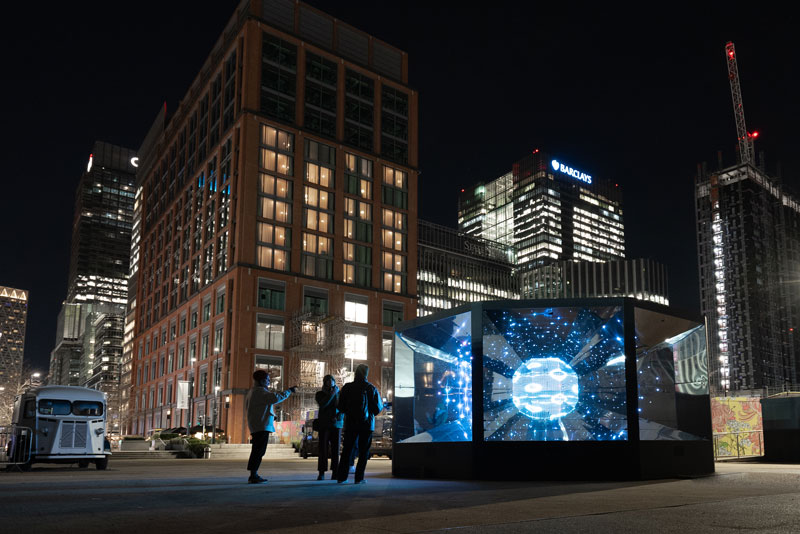Geist
Geist is a large-scale sculpture shaped like an octagonal carousel, 6m in diameter, each of its faces a 3x3m window into a figment of reflection and light, created by a mirror illusion and showing a suspended illuminated orb. The illusion is interactive; only by the proximity and movement of the audience, does the suspended particle of light come to life. Individually addressable LED modules start flickering and glimmering in the presence of people. The public are the cause of the artwork’s existence, their interactions eliciting a response from the artwork; a version of the ‘hide and seek’ played out in a neutrino detector where only an interaction with an atom reveals the neutrino.
The scientific narrative of Geist has involved input from particle physicists at the Rutherford Appleton Laboratory, part of the Science and Technology Facilities Council, and the Physics Department at Oxford University. The collected group of physicists have provided access to and context for real neutrino oscillation measurements from the T2K neutrino experiment in Japan. In collaboration with new-media artist Motus Art sound artist Dan Bibby, This is Loop have re-interpreted actual neutrino interactions seen by T2K, using input from motion sensor cameras and complex code, into the animation of moving light and audio for Geist. The type of ‘neutrino’ seen will depend on the neutrino oscillation probabilities from T2K. When the audience ‘interacts’ with the sculpture, Geist will reflect a visual and audio representation of the detection of a neutrino.
Neutrinos are the most abundant massive particles in the universe and in their very nature are minuscule particles that are extremely hard to detect but are believed to permeate the universe. One of the many mysteries surrounding neutrinos is that the three different types of neutrinos can change into each other. We know there are three neutrino types, the electron, muon, and tau neutrino, to accompany their charged heavier cousins, the electron, muon and tau (the latter two are essentially just heavier electrons). However, depending on the neutrino’s energy and distance travelled, a neutrino created as one type may be detected as a different type altogether. This is a process called “neutrino oscillation” and scientists believe understanding neutrino oscillations could potentially shine light on why the universe exists. Neutrinos are extremely elusive and Particle physicists need to use mammoth neutrino detectors to hunt and trace these so called ‘ghost particles’. Only on the extremely rare occasion that a neutrino interacts by hitting an atom in the detector can these particles be detected, through new charged particles produced by the interaction. Inspired by these enormous neutrino detectors, Geist (from the German word for “ghost”) is an exploration of the complex game of ‘hide and seek’ that scientists play to find and provide evidence for the existence of these particles
T2K uses a muon neutrino beam made at the JPARC particle accelerator, and observes this beam at two sites, a Near site at JPARC to measure the neutrinos before oscillations, and a Far site 295km away, using the giant Super-Kamiokande detector.
Motus art is the moniker of Owen McAteer, a creative coder and generative artist who uses code to create unique pieces of animated digital art. Owen has had his work shown in exhibitions and galleries around the world including New York, Woodstock GA, Madrid and Germany.
Dan Bibby is a Brighton based musician, sound designer and programmer. Along with providing the audio for Geist, his work can also be heard as part of his band Green Gills.
The UK’s Science and Facilities Technology Council have major research and innovation campuses at Harwell, Daresbury and research facilities across the UK and overseas. On behalf of the UK they support fundamental research in astronomy, physics, computational science and space science.
Oxford University Physics Department is a world-leader in experimental particle physics research. Their work in neutrino physics includes neutrino oscillation and interaction measurements in the T2K, MicroBooNE, Hyper-K, DUNE, and SNO+ experiments.
‘GEIST’
Concept: This is Loop
Design: This is Loop
Fabrication: This is Loop
Programming: This is Loop
Animations and Code: Owen McAteer
Audio production: Dan Bibby
Photography: This is Loop & Sean Kerr
Videography: This is Loop
Huge thanks to the STFC and Oxford University Particle Physics for helping us shape the narrative for the scientific concept of the piece as well as granting us access to data from the T2K and Super Kamiokande Neutrino experiments.
